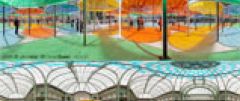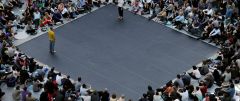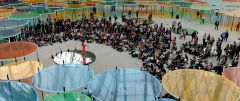Reflection
Daniel Buren has sometimes used reflections – in mirrors, shiny materials or water. The reflection’s primary property is the inclusion of the space around the work (it is impossible to reflect just the work itself), stressing the artist’s position on the fundamental interrelation between the object and its context.
Moreover, a reflection does not stay still, it depends on the viewer’s position. Here we find another idea defended by Daniel Buren: no single viewpoint dominates. The mirror therefore contextualises the object in relation to the spectator’s movement: there are an infinite number of possible viewpoints and they are always fragmentary.
In some cases, reflection is used to obtain an optical effect: the impression of infinity when two mirrors are placed face to face, multiple reflections in corners, disappearing borders or startling periscopic vision.
Apart from these effects, Daniel Buren uses the mirror as a “third eye” so we can see what is in front and behind us simultaneously. The mirror “is not necessarily there to reflect something, but to show particular things that only mirrors can show. I would go so far as to say that the mirror never imitates anything, but always shows something else. More than that, it transforms the space and lets us see more and differently.”
Reflection offers a new, dynamic way of seeing. It also refers the work to something else, to the exterior or to the viewer. The question of the mirror obviously intrigued many twentieth-century artists, but Daniel Buren’s references go much further back, to the Renaissance, with the regret that the “reflective pieces on some of Uccello’s battle scenes” have not survived.





